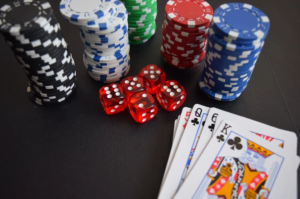
The fascinating world of gambling has long been a source of inspiration and intrigue in art and literature. Characterized by chance, risk, and fortune, has captivated artists and writers, urging them to explore its depths and nuances. Through the lens of creativity, gambling has been depicted in various forms, from the visual splendor of art to the compelling narratives of literature, revealing its multifaceted impact on culture and society. As we look into this captivating subject, we uncover the hidden connections between gambling and the artistic and literary worlds, offering a glimpse into the complex interplay between chance and human expression.
Gambling in Visual Art
Artists throughout history have been drawn to the theme of gambling, using their canvases to capture the tension, drama, and unpredictability inherent in games of chance. From the somber realism of Caravaggio’s card players to the vibrant depictions of casino life in modern art installations, gambling has served as a powerful metaphor for the human condition. These artworks not only reflect the ups and downs of gambling but also offer insight into societal attitudes towards risk and fortune. Through the artist’s eye, we see the hopes, fears, and desires of those who gamble, immortalized in paint and sculpture.
One of the most striking aspects of gambling in art is its ability to convey the intense emotions and psychological states of its participants. The anticipation of the next card turn, the despair of loss, and the exhilaration of victory are all vividly portrayed, providing viewers with a visceral understanding of the gambling experience. This emotional depth makes gambling a compelling subject for artists, allowing them to explore themes of fate, destiny, and the human pursuit of happiness.
Literary Journeys into the World of Gambling
In literature, gambling takes on a myriad of forms, from the backdrop of high-stakes casino scenes to the central theme of novels that search deep into the psychology of gambling. Classics such as Fyodor Dostoevsky’s “The Gambler” offer a profound exploration of the compulsive nature of gambling and its effects on the human psyche. Here, gambling is not merely a pastime but a lens through which the complexities of desire, addiction, and redemption are examined.
Contemporary literature continues this tradition, weaving gambling into narratives that challenge our perceptions and push the boundaries of storytelling. Through the lives of their characters, authors reveal the transformative power of gambling, highlighting its capacity to alter destinies and shape identities. Whether used as a plot device or a symbol of broader themes, gambling remains a potent element in the literary world, captivating readers with its inherent drama and uncertainty.
The Hidden Connections: A Reflection of Society
The representations of gambling in art and literature are not isolated phenomena but reflections of the broader cultural and societal context in which they were created. They serve as mirrors, revealing our collective fascinations, fears, and attitudes towards chance, risk, and the unknown. By exploring these hidden connections, we gain insight into the role of gambling in human culture, from ancient times to the digital age, where online platforms like GemBet live casino have transformed the gambling landscape.
Gambling in Literature and Music
As we continue our exploration of the hidden connections between gambling and the world of art, literature, and music, we seek deeper into the rich tradition of cultural expression that gambling has inspired. We focus on the intricate relationships between gambling, literature, music, and their collective impact on society, revealing how these elements interweave to create a fascinating narrative of human experience.
Gambling’s Influence on Literature
Gambling’s presence in literature spans centuries, offering a window into the human psyche and the complexities of fate and chance. In literature, gambling is not merely an action but a symbol loaded with meaning. It serves as a metaphor for the unpredictability of life, the risks we take, and the consequences of our choices. The narrative tension created by gambling scenes in literature often mirrors the internal struggles of characters, serving as a crucible where their true natures are revealed.
One can see this thematic exploration in the work of modern authors who use gambling as a backdrop to explore themes of addiction, morality, and the pursuit of the elusive. It’s a narrative device that enriches the story, adding layers of complexity and depth. Such narratives remind readers of the stakes involved in gambling, both at the tables and in life, drawing a parallel that resonates with the universal human condition.
Rhapsody of Gambling in Music
In music, gambling has served as an inspiration for countless composers and songwriters, who weave the essence of gambling into their melodies and lyrics. The temptation of the risk, the adrenaline from the win, and the despair of loss find their expression in the universal language of music. From operas to folk songs, the theme of gambling is ever-present, echoing the highs and lows experienced by those who dare to wager.
Classical compositions often interpret literary themes of gambling, transforming them into powerful musical narratives. Composers like Tchaikovsky and Strauss have masterfully captured the essence of gambling stories such as “Romeo and Juliet” and “Don Quixote,” turning them into auditory experiences that move and inspire. These pieces serve as a bridge between the worlds of literature and music, demonstrating how gambling’s thematic richness can be translated across different forms of artistic expression.
Sociocultural Impact: Reflecting and Shaping Perceptions
The portrayal of gambling in art, literature, and music not only reflects societal attitudes but also has the power to shape them. These artistic expressions offer critical insights into the role of gambling in culture, highlighting its attraction and dangers. By engaging with these themes, artists and writers open up conversations about the ethics of gambling, the nature of luck and destiny, and the human propensity for risk-taking.
In the digital age, online platforms like GemBet have revolutionized the gambling experience, making it more accessible than ever. This transition has sparked new narratives and artistic explorations, further enriching the cultural dialogue surrounding gambling.
FAQs
What are some iconic artworks featuring gambling?
Iconic artworks featuring gambling include Caravaggio’s “The Cardsharps” and Georges de La Tour’s “The Cheat with the Ace of Diamonds,” which capture the tension and drama of gambling.
Can you recommend any books where gambling is a key theme?
“Fools Die” by Mario Puzo and “The Gambler” by Fyodor Dostoevsky are classic novels where gambling plays a central role, offering deep insights into all aspects of it.
Are there any famous musical pieces inspired by gambling?
Yes, Tchaikovsky’s “The Queen of Spades” and Strauss’s “Don Quixote” are examples of famous musical pieces where gambling themes play a pivotal role.
In conclusion, the exploration of gambling in art, literature, and music reveals a fascinating intersection of human experiences. These expressions not only offer entertainment but also pose profound questions about the nature of risk, choice, and destiny. As we continue to engage with these themes, we deepen our understanding of the complex relationship between gambling and cultural expression.






